
The dot moth is a moth of the family Noctuidae. The species was first described by Carl Linnaeus in 1761. It is a very distinctive species with very dark brown, almost black, forewings marked with a large white stigma from which the species gets its common name. The hindwings are grey with a dark band at the termen. The wingspan is 38–50 mm. It flies at night in July and August and is attracted to light, sugar and flowers.

The black arches or nun moth is a small Palaearctic moth. It is considered a forest pest.

Angerona is a monotypic moth genus in the family Geometridae erected by Philogène Auguste Joseph Duponchel in 1829. Its only species, Angerona prunaria, the orange moth, was first described by Carl Linnaeus in his 1758 10th edition of Systema Naturae.

Colias palaeno, known by the common names moorland clouded yellow, palaeno sulphur, and pale Arctic clouded yellow, is a butterfly in the family Pieridae.

The Lapland ringlet is a member of the subfamily Satyrinae of the family Nymphalidae. It is restricted to sunny patches in very damp spruce and pine forests and forested unmanaged peatlands. The larva feeds on various grasses and related plants and winters twice. A dry period in the habitat will result in the decline of the species.

Eurois occulta, the great brocade or great gray dart, is a moth of the family Noctuidae. It is found in northern and central Europe, North Asia and central Asia to the Pacific Ocean and Japan. Also the northern parts of North America. In addition, it is found in Greenland and Iceland. In the south in northern Spain and on the Balkan peninsula.

Boloria freija, the Freija fritillary, is a butterfly of the family Nymphalidae with a circumboreal distribution. It occurs in bogs and tundra. Its range includes Northern Europe to the north of 60° N, occasionally more southern locations, the Urals, Siberia, the Russian Far East, mountains of northern Mongolia and Hokkaido, as well as North America, extending in the Rocky Mountains to 35° N.
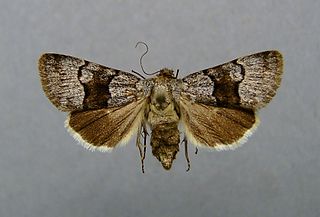
Sympistis is a genus of moths of the family Noctuidae. The genus was erected by Jacob Hübner in 1823.

Dasypolia templi, the brindled ochre, is a moth of the family Noctuidae. The species was first described by Carl Peter Thunberg in 1792. It is found in northern Europe up to central Siberia and more to the south in mountainous areas.

Coranarta cordigera, the small dark yellow underwing, is a moth of the family Noctuidae. The species was first described by Carl Peter Thunberg in 1788. It can be found in parts of Europe, mainly in the north. In central and southern Europe it is only found in mountainous areas. In the Alps for instance, it is found up to elevations of 2,200 meters.

Sympistis funebris is a moth of the family Noctuidae. It is found in Fennoscandia, the Alps, northern Russia through Siberia to Japan. It is also found in the northern parts of North America.
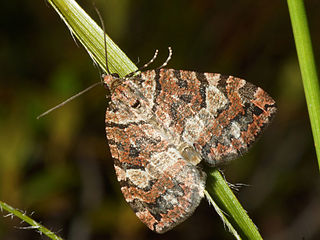
Hydriomena furcata, the July highflyer, is a moth of the family Geometridae. The species was first described by Carl Peter Thunberg in 1784. It is found in the Holarctic ecozone.
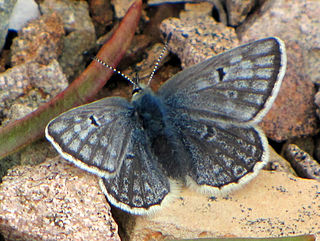
Agriades glandon, the Arctic blue or Glandon blue, is a species of butterfly in the family Lycaenidae. It in found in Eurasia and North America.

Hadula melanopa, the broad-bordered white underwing, is a moth of the family Noctuidae. The species was first described by Carl Peter Thunberg in 1791. Subspecies H. m. melanopa is found in northern Scandinavia; subspecies H. m. rupestralis is found in the Alps, the Balkan Mountains and the Apennine Mountains; subspecies H. m. brunnea is found in mountainous areas of Great Britain and subspecies H. m. koizumidakeana is found in Japan.

Entephria caesiata, the grey mountain carpet, is a moth of the family Geometridae. The species was first described by Michael Denis and Ignaz Schiffermüller in 1775. It is found in the mountainous areas of Europe, the Caucasus, Asia Minor, Armenia, Russia, Russian Far East, Siberia, northern Mongolia, Sakhalin and Honshū in Japan.
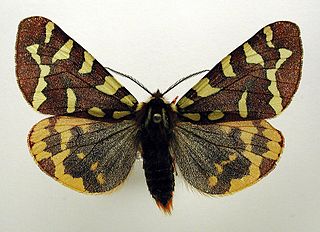
Arctia lapponica is a moth of the family Erebidae first described by Carl Peter Thunberg in 1791. It is found in northern Eurasia and the Arctic part of North America.
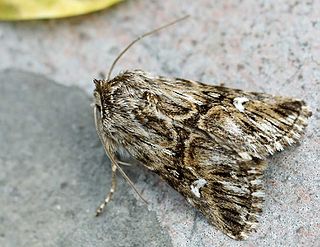
Oncocnemidinae is a subfamily of moths which belong to the large moth family (Noctuidae). In contrast to most other members of the family, they fly during the day. Oncocnemidinae are small, dark coloured moths, but the backs of their wings are generally white with broad, black stripes.

Sympistis chionanthi, the grey o moth or fringe-tree sallow, is a moth of the family Noctuidae. The species was first described by James Edward Smith in 1797. It is found from North Dakota to Nova Scotia south to at least to Virginia and Kansas. The habitat consists of deciduous woodlands, including riparian woodlands, but also plantations and farmyard shelterbelts.
Sympistis dentata, the toothed apharetra moth, is a moth of the family Noctuidae described by Augustus Radcliffe Grote in 1875. It is found from Yukon, the Northwest Territories, and British Columbia to Newfoundland and the northern United States, south in the east to New Jersey. It is listed as threatened in the US state of Connecticut.

















